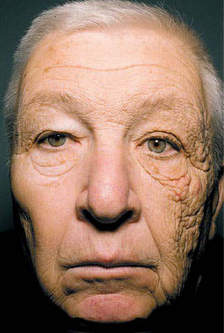
It appeared in Le Monde in Paris one day and the Herald Sun of Melbourne the next. The viral image, reposted on news sites and Facebook pages around the world, is that of a 69-year-old truck driver.
A part of April’s images in clinical medicine section of the New England Journal of Medicine, interest in the photograph has grown with the heat index. Of course, the story did not start, nor does it end, with a picture.
Jennifer Gordon, MD, was a research fellow at Northwestern University Feinberg School of Medicine last year when the man arrived at the clinic of Joaquin Brieva, MD, associate professor in dermatology. Referred to Brieva by a colleague, the delivery-truck driver finally sought medical advice after the persistent questioning of his grandkids.
“We were quickly amazed at the stark one-sidedness of his condition,” said Gordon, now a dermatology resident at the University of Texas Southwestern Medical Center in Austin. “After realizing he was a truck driver for the majority of his life, we recognized it as a pronounced example of ultraviolet-induced sun damage.”
Ultraviolet-A (UVA) rays can transmit through clouds and even window glass, penetrating the epidermis and upper layers of the dermis. Chronic exposure has been linked to aging, wrinkles, and destruction of the skin’s elastic fibers. Over the past quarter-century, the increased thickening of the man’s skin became increasingly prominent on the more sun-exposed side of his face. Although exposure to UVB rays – the kind that cause sunburn – is linked to higher rates of skin cancer, recent research suggests UVA rays can damage DNA in the skin’s deepest layers, increasing the risk that they become cancerous.
“Dermatologists are quite familiar with the photoaging that occurs on the most sun-exposed areas of the body. They are also aware that skin cancer in America is more prevalent on the left side of the face and along the left arm,” Brieva said. “The case report is a unique and extreme example of a very common disorder, but we never expected our article to become a viral phenomenon.”
For the truck driver, whose condition is known as unilateral dermatoheliosis, the day-to-day work regimen now includes the use of skin protection. And although skin cancer was not present, the image is worth a thousand warnings.
“The clear message to the rest of the medical community and the world is that the sun greatly accelerates the aging process and is also a complete carcinogen,” Brieva said. “Sun-avoidant behavior, the use of sun-protective gear, and UVA and UVB sunblocks are encouraged not only for cosmetic reasons, but for cancer prevention as well.”






